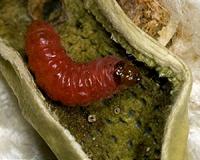 |
Hanoi, Vietnam (UPI) Nov 10, 2010 A $600 million global scheme to boost rice yields was announced in Hanoi Wednesday. Launched by the International Rice Research Institute and the Consultative Group on International Agricultural Research, the Global Rice Science Partnership is expected to lift 150 million people out of poverty by 2035 and prevent the emission of greenhouse gases by an amount equal to 1 billion tons of carbon dioxide, IRRI said. The GRiSP research will study the genetic diversity of rice by sequencing and analyzing more than 1,000 rice strains to identify genes for desirable traits such as improved yield and climate tolerance. "Given that rice is a staple food for more than half the global population and in most of the developing world, there is no question that availability of rice is equated with food security," IRRI Director General Robert Zeigler said in a news release. The initiative is expected to boost supplies enough to reduce anticipated increases in rice prices by an average of at least 6.5 percent by 2020, and at least 13 percent by 2035. One-fifth of the world's population -- more than 1 billion people -- depend on rice cultivation for their livelihood, IRRI says. Today, there are some 120,000 varieties of rice. About 90 percent of the world's rice is grown in Asia. IRRI said the GRiSP research would significantly reduce greenhouse gas emissions from rice production through the adoption of improved irrigation methods and by avoiding deforestation. More than 3 million acres of forest, wetlands and other natural ecosystems would also be saved by 2035 because higher yields would mean rice production wouldn't need to expand into new areas. Because of dwindling research funding during the last 10 to 15 years and a lack of commercial interest in the crop, the average global growth rate in rice yields has dropped to less than 1 percent per year since 2000, IRRI says. But Greenpeace warned against field trials of genetically engineered rice. Releasing GE rice in Asia could irreversibly affect traditional rice varieties and wild ancestors of rice, Greenpeace says. "It is time that IRRI lets go of the illusion that GE is a tool that would benefit farmers and humankind. IRRI should start focusing its attention and resources on tools that would actually work to ensure that rice developers, growers and consumers have access to non-GE rice that is free of corporate control," Daniel Ocampo, Sustainable Agriculture Campaigner of Greenpeace Southeast Asia, said in a news release.
earlier related report A detailed genetic study of one of the first farming communities in Europe, in central Germany, reveals marked similarities with populations living in the Ancient Near East -- modern-day Turkey, Iraq and other countries -- rather than those from Europe, a release from Australia's University of Adelaide says. "We have finally resolved the question of who the first farmers in Europe were -- invaders with revolutionary new ideas, rather than populations of Stone Age hunter-gatherers who already existed in the area," says Adelaide's Wolfgang Haak, a researcher at the university's Australian Center for Ancient DNA. The DNA used in this study came from a complete graveyard of Early Neolithic farmers unearthed at the town of Derenburg in Saxony-Anhalt, central Germany, the researchers said. "This overturns current thinking, which accepts that the first European farming populations were constructed largely from existing populations of hunter-gatherers, who had either rapidly learned to farm or interbred with the invaders," Professor Alan Cooper, the project leader, said. The study was published in the online peer-reviewed science journal PLoS Biology.
Share This Article With Planet Earth
Related Links Farming Today - Suppliers and Technology
 New Insect Birth Control Strategy Zaps Cotton Pests
New Insect Birth Control Strategy Zaps Cotton PestsTucson TX (SPX) Nov 09, 2010 Using pests as part of an insect birth control program helps to get rid of them, UA researchers find. A new approach that combines the planting of pest-resistant cotton and releasing large numbers of sterile moths has virtually eliminated of the world's most destructive cotton pests from Arizona. The novel control strategy, published in the Nov. 7 advance online publication of the journal ... read more |
|
| The content herein, unless otherwise known to be public domain, are Copyright 1995-2010 - SpaceDaily. AFP and UPI Wire Stories are copyright Agence France-Presse and United Press International. ESA Portal Reports are copyright European Space Agency. All NASA sourced material is public domain. Additional copyrights may apply in whole or part to other bona fide parties. Advertising does not imply endorsement,agreement or approval of any opinions, statements or information provided by SpaceDaily on any Web page published or hosted by SpaceDaily. Privacy Statement |